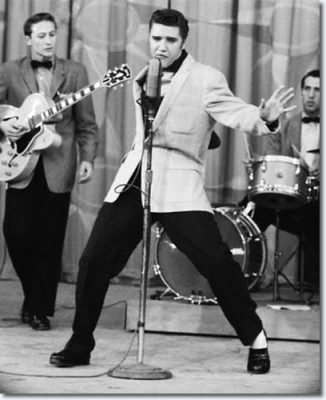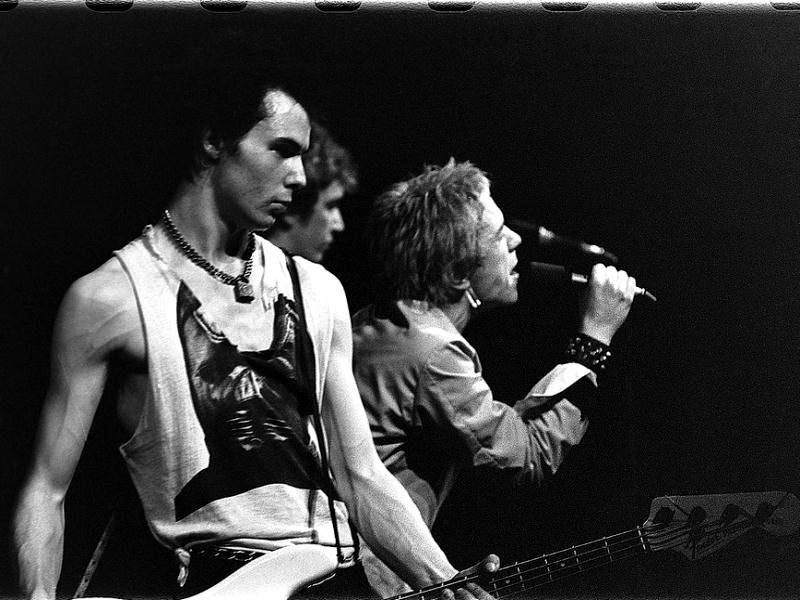Curating punk rock
10 February 2017 – Matthew Barlow

Elvis Presley in his iconic pose. Photo credit: Elvis Presley Music.
I was reading in The New Yorker a few weeks ago about the “museumification” of rock music. The article was about an exhibit on the Rolling Stones in New York City, Exhibitionism!, and the curator, Ileen Gallagher, was talking about her experiences at the Rock ’n’ Roll Hall of Fame in Cleveland. She argues that it was the first place rock music was museumified. Gallagher gave credit to MTV, claiming that it gave rock music a visual culture. She is flat-out wrong. Rock music has had a visual culture from the get-go. Think of those iconic images of Elvis Presley, with his stand-up microphone thrown back to his side, as he shakes his hips and dances. Or the Beatles, with their iconic 1967 album cover for Sgt. Pepper’s Lonely Hearts Club Band.
Or, there is the great punk band the Sex Pistols. In many ways, the Pistols were a carefully contrived multi-media assault on rock music and British society in the late 1970s. The band’s manager, Malcolm McLaren, carefully constructed and curated a visual culture for the band based on frontman Johnny Rotten’s (né Lydon) unique style.
McLaren’s partner, in romance and business, was the fashion designer Vivienne Westwood, and together, they operated a clothing boutique in Chelsea, London, called SEX. The Sex Pistols had the run of the store, picking and choosing their clothing (with McLaren’s approval). McLaren also carefully controlled nearly every other aspect of the Pistols’ public life. And he manufactured many of the “crises” that the Sex Pistols experienced during their short career at the end of the 1970s. However, while McLaren carefully curated the visual culture of the Sex Pistols, they were an authentic band. They formed two years before McLaren became their manager and they wrote their own music.

Sid Vicious, Steve Jones, and Johnny Rotten of the Sex Pistols. Photo credit: Wikimedia Commons.
When McLaren died in 2010, his trove of Sex Pistols and punk-related memorabilia went to his son with Westwood, Joe Corré. For the past half decade, Corré has wondered what to do with all of the detritus of the Sex Pistols and the early years of punk. In March 2016, Corré announced plans to torch around £5 million worth of punk memorabilia.
He was appalled by what has happened to punk since the late 1970s. In particular, Corré was gobsmacked and offended by Punk.London, an on-line exhibit site to complement a year-long commemorative program to celebrate the 40-year anniversary of the rise of punk in 2016. I can understand this. Punk.London comes complete with a tacky boutique, where on-line, one could buy over-priced and decidedly non-punk t-shirts commemorating the 100 Club, where the Sex Pistols played their first gig. While Corré hyperbolically claims that the Queen had given her official imprimatur to Punk.London, it was supported by the British Library, British Fashion Council, the National Lottery, and the Mayor of London.
Aging punks may be forgiven their skepticism, of course. It was not for nothing that the Sex Pistols commemorated Queen Elizabeth’s Silver Jubilee in 1977 with the classic track “God Save the Queen.” The entire purpose of punk was to rile the establishment, to challenge convention, to point out that the status quo of late 1970s England was not good enough. For Corré, the idea that the very establishment that the Sex Pistols, the Clash, the Damned, and other English punks challenged should be behind the movement’s commemoration is appalling: “Rather than a movement for change, punk has become like a fucking museum piece or a tribute act.”
Indeed. In 2012, London hosted the Summer Olympics and in the countdown to the opening, the Clash’s 1979 track “London Calling” was featured in official adverts. This was a classic example of the denuding of punk’s message. “London Calling” is not a happy song. It is set in a dangerous, depraved London, one still feeling the effects of the Blitz of World War II, three decades previously. And as I write this article, the Specials’ “A Message to You, Rudy” is playing on the TV in an advert for Fidelity Investments.
So Corré had a point. He set the date of 26 November 2016, commemorating the 40th anniversary of the release of the Pistols’ Anarchy in the UK. And he carried through on this threat, torching his legacy on a barge on the Thames. This was also symbolic, as it recalled the Sex Pistols’ trolling of the Queen on 7 June 1977 by playing a hired boat on the River Thames outside of Parliament.
Personally, I am of two minds about Corré’s actions. As a public historian, I know I should be appalled by Corré’s vandalism. He has willfully torched and destroyed £5 million worth of memorabilia. This included original Westwood-designed clothing, initial pressings of Sex Pistols’ singles and albums, posters, and other representations of visual culture. My inner public historian says this all needed to end up in a museum, to be displayed, for the history of punk’s challenge to authority to be explained, contextualized, and used as a teaching moment. The activist in me thinks that punk’s message of the late 1970s and early 1980s is essential for today, as we face increased globalization, corporatization, and, of course a world dominated by the likes of Donald Trump, Boris Johnson, Theresa May (who wears Vivienne Westwood’s designs), and Marine Le Pen. There are valuable lessons to be learned from punk.
On the other hand, as an aging punk, I sympathize with Corré. Punk has been co-opted by the mainstream; it is used to sell everything from cars to retirement plans. It is on display in shopping malls around the world. It has been shorn of its politics and cleaned up, given a bath, and become an essential suburban culture. London.Punk isn’t going to do anything to actually remind people of the politics behind punk. Why would it, when people can giggle at the ridiculous hairdos and get themselves a 100 Club t-shirt?
Advertising is focused on taking stories about change and revolution to sell product. The lesson to be learned from individuals and movements who challenged and changed society is not that. That’s unimportant. What is important is how Volkswagen, Fidelity, PepsiCola, and so on have used the spirit of misfits, oddballs, and revolutionaries to challenge conventional thought in car design, retirement planning, and soda.
So I am left with questions about what we do with that which we cannot properly commemorate, curate, and exhibit? Punk is not difficult knowledge in the traditional sense; it’s a cultural movement. But I find myself wondering if the techniques used to curate and exhibit the undescribable might be useful in the case of protest movements that were a riot of color and sound like punk. Or are such things un-commemoratable, un-curatable, un-exhibitable?
~ Matthew Barlow teaches at the University of Massachusetts Amherst and is an aging punk. His first book, Griffintown: History & Memory in an Irish Diaspora Neighbourhood, is out in May from UBC Press.




What a great post, Matthew. I recommend checking out the work that Greg Kessler (full disclosure, I am Greg’s MA thesis advisor) is doing to curate the history of the punk scene in St. Louis. Greg is using Omeka to document and share the music, shirts, flyers, buttons, zines, and anything else created by punks in one midwestern city. Check it out: https://stlpunkarchive.omeka.net/
More broadly, though, Greg has a vision of curating punk on a scene-by-scene basis using open-source digital history tools like Omeka. This may be a way of curating punk that is decentralized, open-source, and focused less on a few rock stars (sell outs?) and more on the thousands of musicians and fans who built and sustain punk as a labor of love. On the technical side, Greg’s focus on getting local music history off of commercial social media—tumblr, FaceBook, etc.—and onto sustainable, non-commercial sites retains a bit of punk’s spirit in my opinion.
Now that Danny Vapid lives in St. Louis, you should check out his collection.
Congratulations on the forthcoming book, Matthew!
I’m a historian and a punk rock fan, and I love Corré’s gesture. i think it’s perfect. And of course, he couldn’t prevent the rest of London from photographing and sharing his gesture, which will be part of the punk rock archive anyway!
Enjoyed this a lot.
You might enjoy this:
https://ebryans.wordpress.com/2016/12/18/punk-40-years-young-and-so-much-more-than-punk-rock-though-the-music-is-great
I still listen to punk most days though am now mid-50s!
Early Clash, 999, early Joy Division, Pistols, etc
Memories …
What will we have, when we have forgotten our history? Will we have to climb the same mountains, over and over again, without leaving any wisdom for those who come behind?
On the one hand, I can understand Corré’s decision. The once raw we’ve made precious. The youthful angst has been calmed, corporatized. Hearing Iggy Pop in a GAP commercial, the Buzzcocks in a Toyota commercial. It’s the antithesis to punk’s roots.
With that said, as an aging punk myself, my attic is still home to roughly six cardboard boxes filled with roughly 1,000 punk rock cassettes from my youth, which I can’t seem to let go of. It’s like throwing away a rare jewel — 1,000 of them that also make you bounce like a pogo stick.
Punk was a self-conscious pose, as you point out, a carefully manufactured one. It was self-aware of its own inauthenticity. You cannot get on the good side of its irony, no matter how you treat it: honor it or burn it, it still has the last laugh at you.
mistake